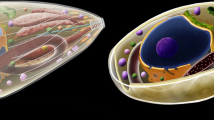Abstract
CONTINUOUS culture of human malaria parasites, Plasmodium falciparum, in human red blood cells was first reported by Trager and Jensen1 and subsequently by Haynes and co-workers2. The culture system described by Trager and Jensen supports the asexual multiplication of P. falciparum and the formation of gametocytes (the precursors of the gametes). Gamete formation by cultured P. falciparum, without which the parasites are unable to infect mosquitoes, has not been previously described. We report here that gametocytes of P. falciparum grown from parasites maintained by continuous culture in vitro are able to develop to the point at which they can be stimulated to undergo gametogenesis (exflagellation).
Similar content being viewed by others
References
Trager, W. & Jensen, J. B. Science 193, 673–675 (1976).
Haynes, J. D., Diggs, C. L., Hines, F. A. & Desjardins, R. E. Nature 263, 767–769 (1976).
Smalley, M. E. Nature 264, 271–272 (1976).
Bishop, A. & McConnachie, E. W. Parasitology 50, 431–448 (1960).
Carter, R. & Nijhout, M. M. Science 195, 407–409 (1977).
Author information
Authors and Affiliations
Rights and permissions
About this article
Cite this article
CARTER, R., BEACH, R. Gametogenesis in culture by gametocytes of Plasmodium falciparum. Nature 270, 240–241 (1977). https://doi.org/10.1038/270240a0
Received:
Accepted:
Issue Date:
DOI: https://doi.org/10.1038/270240a0
- Springer Nature Limited
This article is cited by
-
Malaria parasites utilize two essential plasma membrane fusogens for gamete fertilization
Cellular and Molecular Life Sciences (2022)
-
Gametocytogenesis induction in culturedPlasmodium falciparum and further development of the gametocytes to ookinetes in prolonged culture
Parasitology Research (1989)
-
Complete in vitro maturation of Plasmodium falciparum gametocytes
Nature (1981)
-
Gametocytogenesis by malaria parasites in continuous culture
Nature (1980)
-
Cultivation of malarial parasites
Nature (1978)





